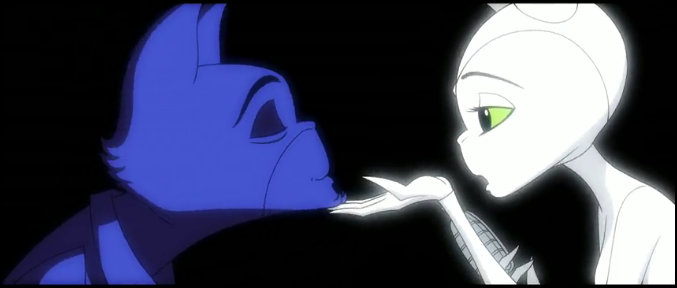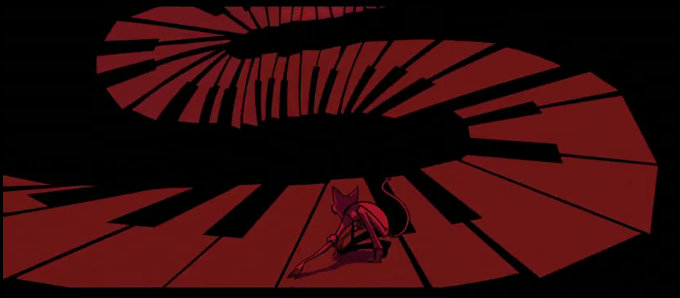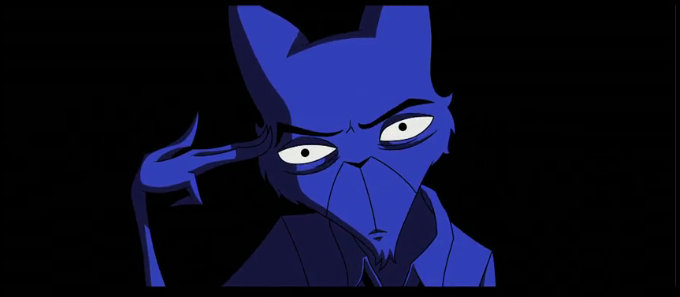Eddie White and Ari Gibson’s “The Cat Piano” delightfullycombines the innocence of animation with the bleak mysteries of film noir, creating a hybrid genre as our expectations of animation’s typical child-like subject matter are interwoven with noir’s darkness and moral ambiguity. What starts off as playful, fun animation with ferociously witty anthropomorphic cats, quickly turns into a tale of despair, corruption, and vengeance.
The story opens with a lonely cat poet recounting his dreary past. He takes us through the crowded urban landscape, filled with bars and nightclubs as musical cats lounge about. We are also introduced to the angelic obsession of this poet’s alienated mind, the soprano siren in white fur.
Things seem splendid as these cats relish in breezy jazz and musical beats, but there is an underlying evil that creeps in and, before they know it, the voices that bring them such joy begin to vanish one by one. The poet quickly transforms into detective mode and makes a terrifying discovery, the blueprints for perhaps the most detestable creation ever conceived: the cat piano. Before he can warn the soprano in white of these dangers, she disappears. Searching for her, the poet descends into madness on his quest for vengeance.
“The Cat Piano” is narrated by the multi-talented Nick Cave, mostly known for his work as front man of the band Nick Cave and the Bad Seeds and for his musical scores of the films The Assassination of Jesse James and The Road. His narration plays off the double meaning of words in a fascinating and playful way, giving this short a significant amount of replay value. His voice adds a flush and sophisticated warmth to the noir underbelly and switches to a treacherous rasp during the short’s darker, almost black moments.
As with most film noir, the short is notable for its harsh contrasts in lighting, made even more substantial by the beautiful animation. The low-key lighting and shadow patterns are exceptional, directing our eyes specifically towards the terror, fear, and heartache the protagonist experiences. Most of the colors are overwhelmingly black and blue, adding atmosphere, mood, and foreshadowing the darkness that looms over this underground world. Green is used to represent the sickness of loneliness brought on by the soprano in white’s disappearance. And a red tint is added in the scenes where the poet reveals his violent and aggressive side in his quest for revenge.
There are several similarities between this short and David Lynch’s feature film Blue Velvet. After being love stricken by a female with a beautiful voice, both protagonists begin to discover hidden secrets in their respective, seemingly happy settings (a white picket fence suburbia in Blue Velvet and a fresh underground music scene in “The Cat Piano”). As they dig deeper into increasingly haunting mysteries, they both horrifically discover the corruption and darkness that exists all around them and within others.
The endings of both films are relatively happy, but with a more monotone revelation as it’s uncertain if either of the protagonists will be able to return to the naivety of their former selves. Their innocence has been forever corrupted and lost.
“The Cat Piano” is a great film noir crime thriller with captivating characters, bold visuals, and spine tingling mysteries. It pushes our comfort zones by blending the innocence typically associated with animation and film noir’s characteristic darkness and gloomy tone. On a larger level this mixing of genres mirrors the protagonist’s loss of innocence, his turn to his darker self. Like him, once you know the cat piano, you cannot walk away unscathed.
–Jon Dewar
__________________
Jon Dewar is a grad student at University of New Brunswick, Fredericton and is working towards a degree in education. He is an avid film fan, interested in both film analysis and filmmaking. Some of his inspirations include directors such as Paul Thomas Anderson, Steve McQueen, and Martin Scorsese. Jon has written numerous screenplays and is working towards eventually producing some of these projects.






Thanks, Jon. Another sleepless night for THIS cat owner.
But, really, yes, thanks. I love the book within the film, the writing aspect, and the alliteration and witty, over-done film noir similes.
NC at the Movies is growing into a unique collection of films and commentary. I don’t think there is anything else like this on the web.
Thanks dg!
I completely agree. There is a great and diverse selection here. I look forward to the films and commentary every week.